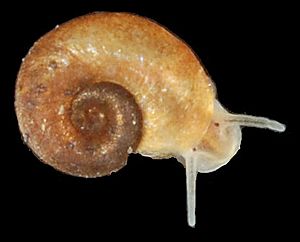Gyraulus parvus facts for kids
Quick facts for kids Gyraulus parvus |
|
|---|---|
 |
|
| Conservation status | |
| Scientific classification | |
| Kingdom: | |
| Phylum: | |
| Class: | |
| (unranked): | |
| Superfamily: |
Planorboidea
|
| Family: |
Planorbidae
|
| Subfamily: |
Planorbinae
|
| Tribe: |
Planorbini
|
| Genus: |
Gyraulus
|
| Species: |
G. parvus
|
| Binomial name | |
| Gyraulus parvus (Say, 1817)
|
|
| Synonyms | |
|
Planorbis parvus |
|
The Gyraulus parvus is a small freshwater snail. People often call it the ash gyro. It belongs to a group of snails known as ram's horn snails.
This snail is originally from North America and the Caribbean. You can find it in places like Canada, the United States, Mexico, Cuba, and Puerto Rico. It has also traveled to other parts of the world. For example, it now lives in Austria, France, and Germany.
Meet the Ash Gyro Snail
The ash gyro snail lives in many types of freshwater places. It likes ponds and lakes. It eats tiny plants and algae called diatoms and periphyton. It scrapes these off rocks and plants. Sometimes, you can see it resting on water plants.
Its Tiny Shell
This snail has a very thin shell. It is clear and looks whitish-gray. The shell is quite small, usually 2.5 to 5 millimeters wide. That's about the size of a small pea!
The shell has 4 to 5 spirals, which are called whorls. The top side of the shell curves inward. The bottom side is mostly flat.
Its Role in Nature
The ash gyro snail plays a part in its ecosystem. Sometimes, it can be a host for tiny parasites. These parasites can cause a skin rash in people. This rash is often called "swimmer's itch." It happens when the parasites try to enter human skin by mistake. They cannot live in humans, so they die, causing an itchy spot.


